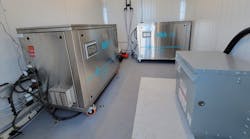The rate at which technology has advanced in the water industry has often been compared to a “stroll” rather than a “sprint.” In other words, it has been slow to change. However, while the industry is not known for its leaps in innovation, it has, over the years, made logical, progressive steps towards meeting the demands of a society that is increasingly environmentally savvy, busier than ever before and hyper cost conscious due to a shaky economy.
This article will explore the evolution of the technologies that, when applied to water treatment products, have served to automate parts of the product or the complete product in answer to the aforementioned societal trends. The focus will be placed upon residential applications and will take a look at the impact of the development of these technologies on how the products have been used and are used today.
No-fuss water softeners
Measuring salt, lugging salt, expelling salt into the environment, frequent visits from the serviceman to change the resin tank, the inevitable cost of having him do so and the overall cost of salt — these are some of the challenges that consumers faced when using the traditional water softener where valves were manually turned to regenerate the system and salt was measured and manually placed in the tank. This process was time consuming, inconvenient, costly, wasteful and prone to human error. As a result, the consumer could often run out of soft water and/or there was a greater chance that the quality of the water would be compromised.
The first step towards automation was the development of a simple time clock managed softener. The time clock was set to regenerate at a specific time of day and day of the week. This eliminated the need to have a serviceman or the consumer attend to the regeneration process, effectively making the system more convenient and helping to lower the cost of maintenance. This also reduced the likelihood of the consumer running out of soft water since the system delivered it more consistently.
The next step was the development of the mechanical meter. This tool monitored the amount of water used and signaled the timer to allow the system to regenerate when the remaining bed capacity went below a preset threshold. This improved the efficiency of the system because it became more responsive to the needs of the household rather than regenerating based on a preset time of day and day of the week. This further reduced the likelihood of running out of soft water since the system delivered it on demand.
The mechanical meter was soon followed by an electronic meter. This upgrade not only offered all of the benefits of both the time clock and the mechanical meter, but it also was able to adjust the reserve capacity of the system based on actual water usage over time. This helped the consumer to manage the amount of salt used. It offered savings in the cost of salt for the consumer as well as reduced the total amount of salt discharged into the environment through the lifetime of the softener.
Today’s technological advancements have lead us to the age of sensor technology driven by a microprocessor. There are two types:
- Sensors that monitor whether or not the system is running out of salt. These can either be placed in the brine line or in the salt tank. This type of sensor is not widely used, but it allows the consumer to be responsive to the system’s salt needs, which helps to maintain the product’s optimal performance.
- Sensors that are in contact with the resin in the softener bed. Many of these monitor the system 24/7 to automatically adjust to changing feed water and water usage conditions. This ensures that up to 100 percent of the treatment capacity of the system can be used before regenerating, conserving both water and regenerant. Also, with the added feature of upflow regeneration, the efficiencies of these systems are improved and the possibility of resin bed compaction is eliminated.
There are also remote monitors available that allow the consumer to keep an eye on the status of the system while not having to be in close proximity to it. These can be placed on a countertop, attached to a wall, etc. and make monitoring the system more convenient for the consumer.
Optimizing filtration
The development of automation technologies for filtration products follows a path not unlike the water softener. It began with a manual filter which relies on the discretion of the consumer to change cartridges. Consumers would be advised to change their cartridges every six to 12 months. However, these instructions were easy to forget and more often than not, the consumer would only remember to do so when there was a significant reduction in flow rate or a noticeable change in the quality of the water. The challenge is that, depending on the state of the cartridge, the quality of the water delivered is typically compromised long before the flow rate slows. And, unless there is a dramatic change in taste, odor or color, the consumer has very little visibility to changes in post filter water quality.
The next wave in monitoring came in the form of meters/timers. Typically, these were manual devices used on POU systems that told the consumer when to change the filters based on the volume of water that ran through them. There were two types of timers: Those that would allow the system to keep operating and those that shut off the water flow after the threshold for the volume running through it had been met. In both cases, the meter/timers helped to improve the optimal performance of the system by automatically reminding the consumer when the cartridge(s) needed to be changed.
The timer was followed by a reminder sticker, a simple label that is in no way attached to the system. Used mostly in retail products, the sticker serves as a reminder to the consumer that the time for changing the cartridge(s) is approaching. On some stickers, the consumer records the data and reminders in the label and some stickers use red dye, which populates the strip until it reaches the designated date at which time the consumer is free to make the change. Since this does not work directly with the system, the consumer has the flexibility of having this little device posted anywhere in the home, thereby automating the process of notification for changing cartridges and making it more convenient for the consumer.
For other filtration systems, differential pressure gauges were developed to work in tandem with controllers. Unlike a reminder label or timer, this is either a mechanical or electronic device that monitors the status of the system’s cartridge(s) by measuring the gradual and inevitable reduction in pressure due to clogging. These devices measured the difference between the inlet and outlet pressure of the filter and would signal the consumer to change the cartridge(s) at a point that was far more accurate to the true state of the system than a measure of time, which more precisely optimized the performance of the system without the consumer having to think about it.
Reverse osmosis (RO) simplified
RO systems went from a manual monitoring process to an electronic TDS meter that would be built into the system. The manual process took the form of simply changing the membranes every year to two years to where one could use a handheld TDS meter. The problem with the former was that the consumer could end up paying for expensive replacement membranes before they were actually needed or may not change the membrane soon enough, thereby compromising the water quality. Also, while the latter presented an improvement in that the change didn’t occur until it was needed, the consumer still faced the inconvenience of having to check the TDS levels themselves or incur the cost of having a serviceman do the same.
The evolution of the electronic TDS monitor eliminated these issues in that it assessed the performance of an RO system to ensure that the system met the pre-programmed requirements for performance. These devices did so by measuring the difference between the conductivity of the inlet and outlet water and comparing that with the standard of TDS to be met. If the TDS ever rose above that standard, the system would indicate that the membrane needed to be changed. No serviceman, no handheld device and no guesswork were needed, just a simple response to an automated process.
The future: Hybrid sensor technology
Most recently, there has been a trend toward adding multiple monitoring devices into one electro chemical water treatment system for POE products. Applying a combination of these devices allows the system to respond to the ever-changing needs of the consumer, the dramatic variations that occur in feed water quality and the complexity of the electro chemical process. Bundling technologies in this fashion or creating a system with “hybrid sensor technology” positions the system to win in the areas of green savings, cost savings, added efficiencies, water quality and overall product performance.
Many electro chemical water treatment systems contain pressure sensors that monitor water demand. They also have meters that measure the water production rate and signal the valve to adjust the flow rate based on the meter and TDS monitors that measure TDS by conductivity within the water. This allows the system to monitor the water quality, system flow rate and the system parameters in order to optimize the water quality and flow rate when it is purifying. It also optimizes water use and water flow to significantly reduce wastewater produced during regeneration.
There are other emerging paths to the next steps in automation as applied to the residential water treatment products. One would be streamlining the bundled devices into a single unit. Another would entail the development of wireless products that allow users to see the functionality of the product on their mobile devices. Clearly the ever-increasing demand for “the easy,” “the environmentally friendly” and the “efficient” creates new and exciting opportunities for innovation.
Chris Gotwald is a global product manager at Pentair Water Purification in Glendale, Wis. With his extensive knowledge of water treatment products and 20 years of engineering experience, Chris is the key point of contact for the development of Pentair’s energy efficient 9100TS and GE Pro Elite softeners with sensor technology and Pentair’s most recent revolution in water treatment technology, the Hybrid DI system. Chris can be reached at [email protected].


